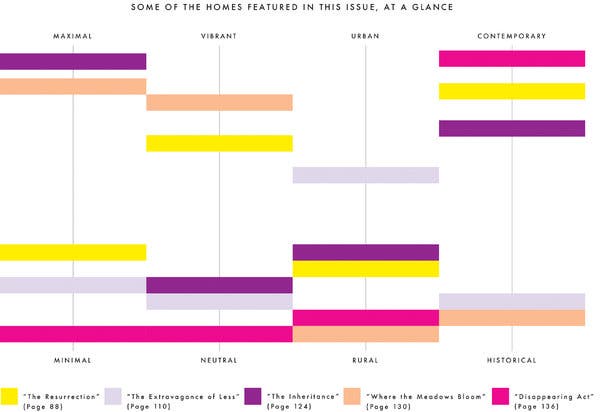Like many a dedicated home-design maximalist, I have moments in which I bemoan my aesthetic tendencies. While normally content to be surrounded by all my stuff — the 10,000 books collected over a lifetime of reading (with room for 2,000 more); the lacquerware from Japan and brass opium weights from Laos and silver figurines from Thailand; the 19th-century pine blanket chest, a fixture from my childhood, packed full with 18th-century American quilts and modern textiles from India, Indonesia, Vietnam, Pakistan and Afghanistan — it takes only a single encounter with true minimalism to make me doubt my own sense of pleasure, which is the worst sort of doubt in its own small way.
Such confrontations are reminders of the serenity and elegance of a space in which the eye, rather than being dazzled, is instead made to focus: not on a wall hung thickly with art, but on a shadow drifting ceilingward; not on a rug, but on a square of sunlight; not on color and pattern, but on texture and form. Real minimalism rarely feels like deprivation — if done well, its proportions and dimensions and light and materials thoughtfully conceived and intelligently executed, it can instead be revelatory, a convincing argument for the way humans are in fact meant to live. For evidence, look at the houses of the designer Vincenzo De Cotiis and the architect Vincent Van Duysen; the former is a witty historical palimpsest, the latter a blurring of interior and exterior, its sun-and-wind-exposed rooms a rebuke to age-old rules about what a shelter is supposed to protect us from. Both of them offer visions of the house stripped of everything superfluous — if only so you can better admire the integrity and beauty of its bones.

Over the years, however, I have come to accept that I will never be a minimalist. Instead, if I’m very lucky, my fate is to live in a house that more closely resembles the ones that the great furniture designer George Nakashima built on his New Hope, Pa., compound. Now occupied by his adult children, they are joyfully cluttered with the mementos of their father’s long life as one of America’s pre-eminent craftsmen: works by Nakashima’s friends and contemporaries, including the artist Ben Shahn and his fellow designer Harry Bertoia, drawings and books and cards, sculptures both made and found. Mostly, they are filled with examples of craft, which, as Michael Snyder writes, Nakashima dedicated his life to preserving and championing. Postwar America, like most other industrialized nations, was “swiftly abandoning its craft traditions in favor of efficiency and disposability, which it called modernity,” and Nakashima’s resistance is written — poignantly, sincerely — all over his houses. Minimalist they’re not. But they, too, offer a reconsideration of how we live, as well as their own kind of argument — not for living with less, but for living with more. Amid what can appear to be chaos, they encourage a kind of focus of their own: For more deliberateness, more life, more love.




